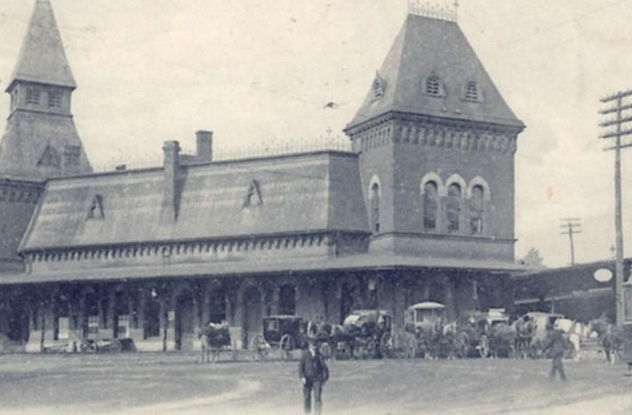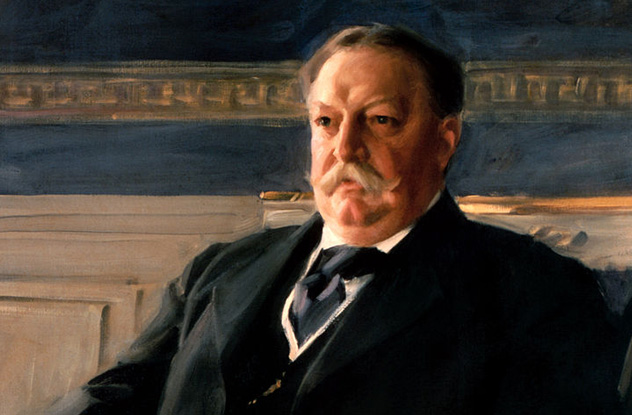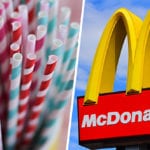 Music
Music  Music
Music  History
History 10 Less Than Jolly Events That Occurred on December 25
 Weird Stuff
Weird Stuff 10 Funny Ways That Researchers Overthink Christmas
 Politics
Politics 10 Political Scandals That Sent Crowds Into the Streets
 Weird Stuff
Weird Stuff Ten Bizarre Facts About The Doge Meme
 Our World
Our World 10 Ways Your Christmas Tree Is More Lit Than You Think
 Movies and TV
Movies and TV The 10 Coolest Stars to Set Sail on The Love Boat
 History
History 10 Things You Didn’t Know About the American National Anthem
 Technology
Technology Top 10 Everyday Tech Buzzwords That Hide a Darker Past
 Humans
Humans 10 Everyday Human Behaviors That Are Actually Survival Instincts
 Music
Music 10 Surprising Origin Stories of Your Favorite Holiday Songs
 History
History 10 Less Than Jolly Events That Occurred on December 25
 Weird Stuff
Weird Stuff 10 Funny Ways That Researchers Overthink Christmas
Who's Behind Listverse?

Jamie Frater
Head Editor
Jamie founded Listverse due to an insatiable desire to share fascinating, obscure, and bizarre facts. He has been a guest speaker on numerous national radio and television stations and is a five time published author.
More About Us Politics
Politics 10 Political Scandals That Sent Crowds Into the Streets
 Weird Stuff
Weird Stuff Ten Bizarre Facts About The Doge Meme
 Our World
Our World 10 Ways Your Christmas Tree Is More Lit Than You Think
 Movies and TV
Movies and TV The 10 Coolest Stars to Set Sail on The Love Boat
 History
History 10 Things You Didn’t Know About the American National Anthem
 Technology
Technology Top 10 Everyday Tech Buzzwords That Hide a Darker Past
 Humans
Humans 10 Everyday Human Behaviors That Are Actually Survival Instincts
10 Mishaps That Nearly Ended A President’s Life
We’ve lost eight sitting presidents to either illness or bullets. Not one of them died because of an accident. But here are 10 close calls.
10Lyndon Johnson Was Nearly Shot By A Secret Service Agent

November 22, 1963 was a dark day in American history. Just 30 minutes after the noon hour on a short Dallas road with the unpretentious name of Elm Street, President John Kennedy was shot and killed in the back of his limo. On JFK’s elite Secret Service detail was four-year veteran special agent Gerald Blaine. Fifty years later, what Blaine remembered about that day was how suddenly the detail had to change their focus from the Kennedy family to that of Lyndon and Lady Bird Johnson. They had no time to feel anger, guilt, or grief.
That night, Johnson returned to Washington and stayed at his estate, The Elms. Blaine had the night shift, and he was standing a lonely watch outside on the grounds. “We were still emotionally in shock over the assassination,” he’d later say. “It had been well over 40 hours since we slept. We didn’t know if it was a conspiracy—or what to expect.”
At 2:15 AM, Blaine heard footsteps in the darkness. The agent unslung his Thompson submachine gun, nestled it against his shoulder, and pulled the bolt back. Blaine hoped the sound of the bolt would give the intruder pause. But the steps kept coming, and a moment later, a dark figure came around the corner of the mansion. Blaine pointed the gun at the figure’s chest and was about to pull the trigger when he recognized the new president.
“I swear he turned white,” Blaine said. “He had just walked out for a breath of air! He hadn’t told anyone. When Kennedy left the house, he would notify the command post.” He added: “[Johnson] struggled to regain composure as the reality of what happened washed over him. Fourteen hours after losing a president, the nation had been chillingly close to losing another one.”
The president turned around without saying a word. He never spoke of the incident. “I had nightmares,” Blaine said. “I had nightmares for years.”
9John Tyler Was Nearly Blown To Pieces

John Tyler will go down as one of the most hated presidents in American history. His own Whig Party kicked him out, nearly his entire cabinet resigned, and Congress set a record for vetoing his cabinet and Supreme Court nominations. There was, therefore, a certain amount of chagrin that Tyler was not among the dead when a cannon exploded while he was on board the USS Princeton on February 28, 1844.
We’ve previously discussed that terrible incident. The president was aboard the Princeton that day at the invitation of Captain Robert Stockton to show off his beautiful new frigate, the first propeller-driven steamship in the US Navy. Stockton had personally paid part of the bill for building the Princeton and had hired the naval innovator John Ericsson to design it. Some 400 of Washington’s elite boarded the frigate that day for a demonstration cruise up and down the Potomac River.
The Princeton carried two of the largest guns in the Navy, both 30-centimeter (12 in) cannons, both designed by Ericsson. One of them—called Oregon—had been built in England and extensively tested. The second—the Peacemaker—was made in an American foundry under Stockton’s supervision and was not, according to Ericsson, sufficiently tested.
The next to the last day of February (it was a leap year) in 1844 was unseasonably warm as the Princeton weighed anchor. The Peacemaker was fired twice early in the cruise without incident. Had the cannon exploded during those two firings, President Tyler and many of the 200 women on board would likely have been killed.
By 3:00 PM, most of the visitors had retired to the quarterdeck for a luncheon of roast fowl, ham, and wine. By then, the frigate had turned around and was heading back down the river and would soon pass Mount Vernon, George Washington’s old home. Secretary of the Navy Thomas Gilmer asked Captain Stockton to fire the Peacemaker again to honor the first president. At first, Stockton refused, but when he learned the request came from his boss, he took it as an order and immediately headed for the deck above the quarterdeck—the foredeck—where the gun was mounted.
A brief announcement was made that the cannon would be fired a third time, and President Tyler’s slave, Armistead, asked to go upstairs for the event. Tyler assented and began to slowly make his way to the foredeck himself. He was climbing the ladder when he heard his son-in-law sing a patriotic ditty about 1776. Tyler stopped to listen.
Just then, the cannon fired. The seams along the gun’s breech gave way, and the Peacemaker split open, spewing shrapnel everywhere, some of it flying above the president’s head. Tyler rushed onto the foredeck to find smoke and carnage.
Secretary of State Abel Upshur had been disemboweled by the explosion, his legs and arms broken. He was almost instantly killed. Armistead and Gilmer were also dead. The millionaire David Gardiner, father of Julia, the woman Tyler wanted to marry, had had his limbs torn off and he, too, had expired. Diplomat Virgil Maxy was also killed, one of his severed arms hitting a woman in the face. In total, eight were dead and 17 were severely wounded, including Captain Stockton. Tyler was unharmed, as were most of the visitors, still on the quarterdeck.
8George W. Bush Choked On A Pretzel
The strange story of how a pretzel nearly killed a president began with White House chef John Moeller. The chef had begun introducing snacks to the White House private quarters during the Clinton administration, and a favorite was a handmade pretzel made by a bakery in Moeller’s hometown of Lancaster, England. According to Moeller, George W. Bush loved them.
On Sunday, January 13, 2002, Bush was alone in the private quarters watching a NFL playoff game between the Miami Dolphins and Baltimore Ravens. His wife, Laura, was in an adjoining room, talking on the phone. The president was eating the pretzels. According to White House physician Dr. Richard Tubb, one “didn’t seem to go down right. The next thing he knew, he was on the floor.”
It’s called vasovagal fainting, a usually harmless episode of fainting when a person’s blood pressure drops, causing a brief loss of consciousness. Except in this case, it was caused by a pretzel lodged in the president’s throat. Fortunately for Bush, the fall to the floor apparently dislodged the obstruction, and he was fine a few seconds later when he revived.
The blackout must have lasted only seconds, Bush later said, because his two dogs were still sitting in the same place they had been perched before the incident. He did, however, bruise his lower level and sported a rug burn on his left cheek for several days.
Moeller said that the incident didn’t deter Bush from eating the pretzels again. He added: “Thank God it didn’t bring down the presidency.”
7Teddy Roosevelt’s Carriage Collided With A Trolley

Theodore Roosevelt was at the end of a tour of New England and riding in an open carriage down South Street, one of the main thoroughfares of Pittsfield, Massachusetts. It was sunny that September 3, 1902, and a large crowd had gathered along the street to cheer the president.
In the carriage with Teddy were Massachusetts governor Winthrop Crane, Massachusetts congressman George Lawrence, and George Cortelyou, the president’s personal secretary. David Pratt drove the carriage, and Teddy’s secret service agent, William Craig, sat beside him.
When South Street rolled down Howard Hill, trolley tracks were in the center of the boulevard. At the bottom of the hill, the tracks swerved to the side of the street, requiring traffic to cross the tracks at that point. A trolley loaded with passengers came down the hill at a fair clip and arrived at the bottom of Howard Hill just as Teddy’s carriage tried to cross the tracks.
Craig saw the trolley just before it collided with them and was heard to say “Oh, my God!” The trolley then hit the carriage just behind Craig’s seat, throwing the agent under the trolley’s wheels. Pratt was thrown from the seat as well but rolled out of the trolley’s way. His shoulder, however, was dislocated.
The rest of the party received only minor cuts and bruises, including an abrasion on the president’s face. But Craig had been mangled and killed. The agent had been with Roosevelt since he became president and was a favorite of Teddy’s son, Kermit.
6Franklin Pierce’s Train Derailed

It is safe to say that Jane Pierce did not care much for the political career of her husband, Franklin Pierce. Shy and reclusive, she detested the social gatherings required of political aspirants. Jane became convinced that the death of their first son, Franklin Jr., was the result of God’s anger over her husband’s career, and she forced him to resign from the Senate. A year later, their second son, Franklin Robert, also died, this time from typhus.
Jane garnered a promise from her husband that he was finished with politics, and both of them focused all their love toward their remaining son, Benjamin (“Bennie”). She was therefore shocked when she learned that Franklin was favored as a presidential contender in 1852. Franklin told her he had not actively sought the nomination, which was not entirely true. And when news arrived that he had been nominated on the Democratic ticket, Jane fainted. She spent the next few months praying that her husband would be defeated. Alas, her prayers were not answered, and Franklin was elected the 14th president in November 1852.
The next month, the Pierces visited Jane’s family in Andover, Massachusetts, during the holidays. On January 6, 1853, the three of them boarded a train bound for home in Concord. A couple miles out of the station, the axle on the car the Pierces were riding broke in two. The car began bouncing violently along the track and uncoupled from the car in front of it. Franklin grabbed Jane and turned to grab Bennie when the car tumbled over a snowy embankment. Bennie was thrown from the car and died instantly. His head was crushed so extensively that he was virtually decapitated. And Franklin and Jane saw it all.
Franklin and Jane received minor injuries, but little could be done about the damage to their marriage. Jane refused to attend her husband’s inauguration and spent most of the next four years in a White House bedroom writing letters to Bennie. Franklin, who already had an alcohol problem, slipped deeper into alcoholism, and what could have been a promising presidency became one of the worst.
5Abe Lincoln Was Nearly Asphyxiated

Despite how his presidency ended, Abraham Lincoln probably cheated death more than any other president with the possible exception of Teddy Roosevelt. Threats against his life were constant during his administration, and we know of at least two attempts to harm him prior to John Wilkes Booth’s successful attack. In August 1864, Lincoln was also nearly shot in the head while riding through the woods. We will never know whether that was an accident or another assassination attempt. He is still the only president to come under fire during a battle (Battle of Fort Stevens, July 1864). And, like Roosevelt, he had more than one nearly fatal accident as president.
Gas lighting was installed in the White House during James Polk’s administration (1845–1849). Because the Polks didn’t trust the new lights, they insisted that at least one chandelier in each room continue to have candles. Sure enough, during the first reception after the installation was complete, the gaslights went out, and the party was finished under candlelight. Polk’s successor, Zachary Taylor, expanded the gaslight system to the offices and private quarters upstairs before his death in 1850.
Lincoln’s office was upstairs just above the East Room, and by the time he took office, the gas lighting was already over a decade old. Then on the night of September 9, 1864, the Commissioner of Public Works Benjamin Brown French recorded in his journal that he had been summoned to Lincoln’s office. The President was found in a room full of gas, the lighting system leaking.
In the mid-1800s, gas supplied to homes and offices was not natural gas as it is today but gasified coal. Coal, when heated and deprived of oxygen, gives off hydrogen, ethylene, and methane gases that burn clean when they are lit. Typically in the 1860s, a room would have the lights attached to the ceiling with a ventilation grille just above it. When a gas line leaked, the greatest danger was carbon monoxide, an odorless gas that causes headaches, nausea, unconsciousness, and eventually death.
French did not indicate what condition Lincoln was in when he arrived, but the president must have had serious symptoms because French did record that the gas nearly killed him. There is no surviving record of Lincoln mentioning the incident.
4John Quincy Adams Nearly Drowned In Tiber Creek

It would be difficult to find Tiber Creek, a tributary of the Potomac River, in today’s Washington, D.C. It now flows in a tunnel under Constitution Avenue and the IRS building. But in 1825, the muddy, marshy creek ran behind the White House. President John Quincy Adams swam daily in the creek when the weather was nice, and it’s been rumored that he often skinny-dipped. He never went alone. Usually, he was accompanied by White House steward Antoine Michel Giusta.
On the morning of June 13, 1825, Adam’s secretary and son John also accompanied them. The bathers came upon an abandoned canoe and decided to take it down the creek to the Potomac then swim back while keeping the boat nearby in the swift current. The president disregarded his son’s worries about the reliability of the canoe and boarded the craft fully clothed while Giusta joined him, naked.
“Before we had got half across the river, the boat had leaked itself half full,” Adams wrote in his diary. “Just at that critical moment, a fresh breeze from the northwest blew down the river as from the nose of a bellows. In five minutes’ time it made a little tempest, and set the boat to dancing till the river came in at the sides. I jumped overboard, and Antoine did the same . . . Antoine, who was naked, reached [the shore] with little difficulty. I had much more [trouble], and, while struggling for life and gasping for breath, had ample leisure to reflect upon my own indiscretion. My principal difficulty was in the loose sleeves of my shirt, which filled with water and hung like two fifty-six pound weights upon my arms.”
The president reached the shore and lay there for a while, gasping for breath. Word quickly reached the White House of Adams’s near-drowning and became the talk of the town for days.
3Teddy Roosevelt Was Nearly Crushed Under A Horse

When Teddy Roosevelt came to the North Dakota Badlands in 1883 to hunt buffalo, he seemed out of place among the rough and rowdy cowboys. He’d grown up a sickly child in a wealthy New York family, stood just 173 centimeters (5’8″), weighed 61 kilograms (135 lb), and wore thick-lensed spectacles. “You could have spanned his waist with your two thumbs and finger,” one cowboy noted.
But he won respect among the cowpokes by riding with them on horseback instead of in the provided wagon, sleeping on the ground, and hunting without complaint in inclement weather. When he returned the next year, he became a rancher, and many thought he looked as hardened and natural in the saddle as any lifelong cowboy. He would later use his rugged outdoorsman image to launch himself into the White House.
On June 2, 1908, Roosevelt was riding with his wife through Washington’s Rock Creek Park. The president was riding an inexperienced horse, and as they crossed the creek and climbed the far embankment, his horse reared. Roosevelt leaned forward and remained in the saddle as the skittish horse regained its composure. The horse, however, reared again at the top of the embankment and this time toppled over backward.
Sensing the danger, Roosevelt slipped his feet out of the stirrups and threw himself to the side before the horse could land on him. They landed in the creek side-by-side, and the president quickly rolled away from the flailing hooves. Once the horse was upright again, Roosevelt remounted him and continued the ride with severe bruises. His experience with horses out West was credited with saving his life.
2William Taft’s Car Collided With A Trolley

William Howard Taft is best known as our heaviest president, tipping the scales at 154 kilograms (340 lb). He was also accident-prone. Even before he was president, he was in two train derailments, surviving both unharmed. While Taft was in Manila, Philippines in 1907, the horses pulling his carriage bolted with him in it, and a bodyguard grabbed the reins, guiding the spooked horses into a ditch.
He had been president just over two months when he was thrown from a horse. He had an even worse record with motor vehicles. Taft had the distinction to be the first president to use an automobile regularly and the first to be pulled over for a traffic violation. He talked his way out of the ticket. While driving on a wet road near Ft. Ticonderoga, New York, the president’s driver lost control of the car, and the jeering crowd watched in “tense silence” as the car skidded. And in March 1910, President Taft had two close calls with trolleys.
On March 17, Taft’s driver veered to miss a pedestrian and almost ran into a trolley. They were not so lucky two weeks later. Taft’s motorcade was traveling down Eighth Avenue in New York City on March 29 when a trolley failed to stop at the intersection of Eighth and 23rd Street. The trolley rammed Taft’s car and carried it a half block before it stopped. The president was unhurt but shaken.
1Abe Lincoln Was Nearly Decapitated By 21-Gun Salute

To get away from the White House and the constant strain of war, Lincoln loved to go to Washington’s Navy Yard, where neither the press nor civilians could follow or bother him. Unfortunately, he was twice nearly killed while at the Navy Yard. Lincoln was watching a demonstration of a rocket on November 15, 1863, when the missile exploded, sending shrapnel all around the president. He was miraculously unharmed.
Seven months earlier, on April 26, Lincoln went to the Navy Yard to tour the frigate Gassendi, becoming the first president to board a French warship. After the tour, Lincoln and his party disembarked into a launch. Thinking Lincoln’s boat was safely headed ashore, the captain decided to give the president a 21-gun salute. Lincoln, however, had asked to row around the ship to examine its hull. As the launch rounded the Gasssendi’s bow, one of the cannon shots went off just above his head. Though the shots were blanks, there was enough flame and sacking debris to have killed the president. Fortunately, he was unharmed.
Steve is the author of 366 Days in Abraham Lincoln’s Presidency: The Private, Political, and Military Decisions of America’s Greatest President and has appeared on KnowledgeNuts.








